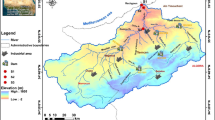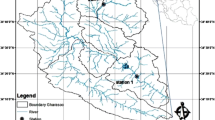Abstract
The objectives of this study were to use both parametric and probabilistic approaches to analyze water column concentrations of both salinity (24,845 measurements) and boron (13,028 measurements) from numerous investigations conducted in the San Joaquin River watershed from 1985 to 2002 to assess spatial and temporal trends and determine the probability of exceeding regulatory targets during both the irrigation and non-irrigation season. Salinity and boron concentrations from 26 mainstem and tributary sites were highly correlated based on this 17 yr data set. Generally, salinity and boron concentrations were higher in winter/spring and lower in summer/fall; higher concentrations of both constituents were reported in tributary sites when compared with the mainstem San Joaquin River. Approximately half the sites showed showed a negative correlation between flow and both constituents. Concentrations of both salinity and boron were somewhat variable with flow conditions for the other sites. Both linear and curvilinear trends were inconsistent over time. The salinity 90th centiles for the 26 sites ranged from 143 to 7,559 μs cm-1 with the highest 90th centiles in tributary sites. Probabilistic analysis of salinity 90th centiles by year for five sites with extensive data showed a significant decrease over time at two sites and no significant trend for the other three sites. The probability of exceeding the salinity targets during either the irrigation (700 μm cm-1) or non-irrigation (1000 μs cm-1) season was greater than 19% for all but three sites. The boron 90th centiles for the 26 sites ranged from 0.41 to 13.6 mg L-1 with the highest 90th centiles from tributary sites. Probabilistic analysis of the boron 90th centile values by year for the five sites with the most extensive data showed a significant decrease over time at two sites and no significant trend for the other three sites. The probability of exceeding the boron target during the irrigation season (0.80 mg L-1) and non-irrigation (1.0 mg L-1) season was greater that 18% for all but three sites. Results from this analysishave important regulatory implications as targets for both salinity and boron are frequently exceeded at various sites in theSan Joaquin River watershed.
Similar content being viewed by others
References
Chilcott, J., Laguna, C. and Dinkler, L.: 1996, ‘Agricultural Subsurface Drainage Program Procedures Manual’, Report, Central Valley Regional Water Quality Control Board, Sacramento, CA.
Draper, N. R. and Smith, H.: 1981, Applied Regression Analysis, 2nd ed., John Wiley & Sons, New York, NY.
Hall Jr., L. W., Giddings, J. M. and Solomon, K. R.: 1999, ‘An ecological risk assessment for the use of Irgarol 1051 as an algaecide for antifouling paint’, Crit. Rev. Toxicol. 29, 367–437.
Hall Jr., L. W., Killen, W. D., Anderson, R. D. and Perry, E. S.: 2002, ‘Analysis of Salinity and Boron Surface Water Monitoring Data from the San Joaquin River Watershed: 1985–2002’, Report, University of Maryland, Wye Research and Education Center, Queenstown, MD.
Milliken, G. A. and Johnson, D. E.: 1984, Analysis of Messy Data, Vol. 1: Designed Experiments, Van Nostrand Reinhold, New York, NY.
Oppenheimer, E. I. and Grober, L. F.: 2002, ‘Total Maximum Daily Load for Salinity and Boron in the Lower San Joaquin River’, Report, Califorinia Environmental Protection Agency Regional Water Quality Control Board Central Valley Region, Sacramento, CA.
Parsons, J. J.: 1986, A Geographers Looks at the San Joaquin Valley, 1986, Geographic Review.
SAS Institute Inc.: 1996, SAS/STAT Software: Changes and Enhancements through Release 6.11. SAS Institute Cary, NC.
Solomon, K. R., Baker, D. B., Richards, P., Dixon, K. R., Klaine, S. J., LaPoint, W. W., Kendall, R. J., Giddings, J. M., Giesy, J. P., Hall Jr., L. W., Weisskopf, C. P. and Williams, M.: 1996, ‘Ecological risk assessment of atrazine in North American surface waters’, Environ. Toxicol. Chem. 15, 31–76.
Westfall, P. H. and Young, S. S.: 1993, Resampling-based Multiple Testing. Examples and Methods for p-Value Adjustment, J. Wiley & Sons Inc., New York, NY.
Author information
Authors and Affiliations
Corresponding author
Rights and permissions
About this article
Cite this article
Hall, L.W., Killen, W.D., Anderson, R.D. et al. Analysis of Historical Salinity and Boron Surface Water Monitoring Data from the San Joaquin River Watershed: 1985–2002. Environ Monit Assess 95, 125–151 (2004). https://doi.org/10.1023/B:EMAS.0000029891.01608.8b
Issue Date:
DOI: https://doi.org/10.1023/B:EMAS.0000029891.01608.8b




